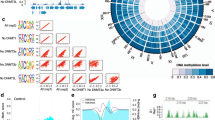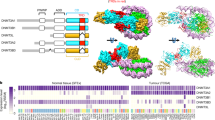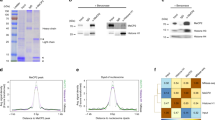Abstract
Methylation of cytosines within the sequence CpG is essential for mouse development1 and has been linked to transcriptional suppression in vertebrate systems2. Methyl-CpG binding proteins (MeCPs) 1 and 2 bind preferentially to methylated DNA and can inhibit transcription3–6. The gene for MeCP2 has been cloned and a methyl-CpG binding domain (MBD) within it has been defined7. A search of DNA sequence databases with the MBD sequence identified a human cDNA with potential to encode an MBD-like region. Sequencing of the complete cDNA revealed that the open reading frame also encodes two cysteine-rich domains that are found in animal DNA methyltransferases (DNMTs) and in the mammalian HRX protein (also known as MIL and ALL-1)8. HRX is related to Drosophila trithorax9,10. The protein, known as Protein Containing MBD (PCM1), was expressed in bacteria and shown to bind specifically to methylated DNA. PCM1 also repressed transcription in vitro in a methylation-dependent manner. A poly-clonal antibody raised against the protein was able to ‘supershift’ the native MeCP1 complex from HeLa cells, indicating that PCM1 is a component of mammalian MeCP1.
This is a preview of subscription content, access via your institution
Access options
Subscribe to this journal
Receive 12 print issues and online access
$209.00 per year
only $17.42 per issue
Buy this article
- Purchase on SpringerLink
- Instant access to full article PDF
Prices may be subject to local taxes which are calculated during checkout
Similar content being viewed by others
References
Li, E., Bestor, T.H. & Jaenisch, R. Targeted mutation of the DNA methyltransferase gene results in embryonic lethality. Cell 69, 915–926 (1992).
Bird, A. The essentials of DNA methylation. Cell 70, 5–8 (1992).
Meehan, R.R., Lewis, J.D., McKay, S., Kleiner, E.L. & Bird, A.P. Identification of a mammalian protein that binds specifically to DNA containing methylated CpGs. Cell 58, 499–507 (1989).
Lewis, J.D. et al. Purification, sequence, and cellular localization of a novel chromosomal protein that binds to methylated DNA. Cell 69, 905–914 (1992).
Boyes, J. & Bird, A. DNA methylation inhibits transcription indirectly via a methyl-CpG binding protein. Cell 64, 1123–1134 (1991).
Nan, X., Campoy, F.J. & Bird, A. MeCP2 is a transcriptional repressor with abundant binding sites in genomic chromatin. Cell 88, 471–481 (1997).
Nan, X., Meehan, R.R. & Bird, A. Dissection of the methyl-CpG binding domain from the chromosomal protein MeCP2. Nucl. Acids Res. 21, 4886–4892 (1993).
Ma, Q. et al. Analysis of the murine All-1 gene reveals conserved domains with human All-1 and identifies a motif shared with DNA methyltransferases. Proc. Natl. Acad. Sci. USA 90, 6350–6354 (1993).
Tkachuk, D.C., Kohler, S. & Cleary, M.L. Involvement of a homolog of Drosophila trithorax by 11q23 chromosomal translocations in acute leukemias. Cell 71, 691–700 (1992).
Gu, Y. et al. The t(4;11) chromosome translocation of human acute leukemias fuses the ALL-1 gene, related to Drosophila trithorax, to the AF-4 gene. Cell 71, 701–708 (1992).
Boguski, M.S., Lowe, T.M. & Tolstoshev, C.M. dbEST—database for expressed sequence tags. Nat. Genet. 4, 332–333 (1993).
Bassett, D.E. et al. Comparative genomics, genome cross-referencing and XREFdb. Trends Genet. 11, 372–373 (1995).
Boguski, M.S. & Schuler, G.D. ESTablishing a human transcript map. Nat. Genet. 10, 369–371 (1995).
Kozak, M. Point mutations define a sequence flanking the AUG initiator codon that modulates translation by eukaryotic ribosomes. Cell 44, 283–292 (1986).
Bestor, T., Laudano, A., Mattaliano, R. & Ingram, V. Cloning and sequencing of a cDNA encoding DNA methyltransferase of mouse cells — the carboxyl-terminal domain of the mammalian enzyme is related to bacterial restriction methyltransferases. J. Mol. Biol. 203, 971–983 (1988).
Boyes, J. & Bird, A. Repression of genes by DNA methylation depends on CpG density and promoter strength: evidence for involvement of a methyl-CpG binding protein. EMBO J. 11, 327–333 (1992).
Bestor, T.H. Activation of mammalian DNA methyltransferase by cleavage of a Zn binding regulatory domain. EMBO J. 11, 2611–2617 (1992).
Zeleznik-Le, N.J., Harden, A.M. & Rowley, J. 11q23 translocations split the “AT-hook” cruciform DNA-binding region and the transcriptional repression domain from the activation domain of the mixed-lineage leukemia (MLL) gene. Proc. Natl. Acad. Sci. USA 91, 10610–10614 (1994).
Prasad, R. et al. Domains with transcriptional regulatory activity within the ALL1 and AF4 proteins involved in acute leukemia. Proc. Natl. Acad. Sci. USA 92, 12160–12164 (1995).
Yu, B.D., Hess, J.L., Horning, S.E., Brown, G.A.J. & Altered Hox expression and segmental identity in MII-mutant mice. Nature 378, 505–508 (1995).
Chinwalla, V., Jane, E.P. & Harte, P.J. The Drosophila trithorax protein binds to specific chromosomal sites and is co-localized with Polycomb at many sites. EMBO J. 14, 2056–2065 (1995).
Altschul, S.F., Gish, W., Miller, W., Myers, E.W. & Lipmann, D.J. Basic local alignment search tool. J. Mol. Biol. 215, 403–410 (1990).
Henikoff, S. & Henikoff, J.G. Amino acid substitution matrices from protein blocks. Proc. Natl. Acad. Sci. USA 89, 10915–10919 (1992).
Hu, C.H., McStay, B., Jeong, S.-W. & Reeder, R.H. XUBF, an RNA-polymerase-I transcription factor, binds crossover DNA with low sequence specificity. Mol. Cell Biol. 14, 2871–2882 (1994).
Cross, S.H., Charlton, J.A., Nan, X. & Bird, A.P. Purification of CpG islands using a methylated DNA binding column. Natl. Genet. 6, 236–244 (1994).
Ausubel, P.M. et al. Current Protocols in Molecular Biology, Vol 2, Sec 12.5 (1994).
Lavery, D.J. & Schibler, U. Circadian transcription of the cholesterol 7-alpha hydroxylase gene may involve the liver-enriched BZIP protein DBP. Genes Dev. 7, 1871–1884 (1993).
Harlow, E. & Lane, D. Antibodies: A Laboratory Manual (Cold Spring Harbor Laboratory, 1988).
Hammarback, J.A. & Vallee, R.B. Antibody exchange immunochemistry. J. Biol. Chem. 265, 12763–12766 (1990).
Heiermann, R. & Pongs, O. In vitro transcription with extracts of nuclei of Drosophila embryos. Nucl. Acids Res. 13, 2709–2730 (1985).
Dignam, J.D., Lebovitz, R.M. & Roeder, R.G. Accurate transcription initiation by RNA polymerase-II in a soluble extract from isolated mammalian nuclei. Nucl. Acids Res. 5, 1475–1489 (1983).
Author information
Authors and Affiliations
Corresponding author
Rights and permissions
About this article
Cite this article
Cross, S., Meehan, R., Nan, X. et al. A component of the transcriptional represser MeCP1 shares a motif with DNA methyltransferase and HRX proteins. Nat Genet 16, 256–259 (1997). https://doi.org/10.1038/ng0797-256
Received:
Accepted:
Issue Date:
DOI: https://doi.org/10.1038/ng0797-256
This article is cited by
-
Electrochemical determination of the activity of DNA methyltransferase based on the methyl binding domain protein and a customized modular detector
Microchimica Acta (2019)
-
The basic helix-loop-helix transcription factor SHARP1 is an oncogenic driver in MLL-AF6 acute myelogenous leukemia
Nature Communications (2018)
-
MBD6 is a direct target of Oct4 and controls the stemness and differentiation of adipose tissue-derived stem cells
Cellular and Molecular Life Sciences (2013)
-
Transcriptome analysis of amoeboid and ramified microglia isolated from the corpus callosum of rat brain
BMC Neuroscience (2012)
-
The histone 3 lysine 4 methyltransferase, Mll2, is only required briefly in development and spermatogenesis
Epigenetics & Chromatin (2009)



